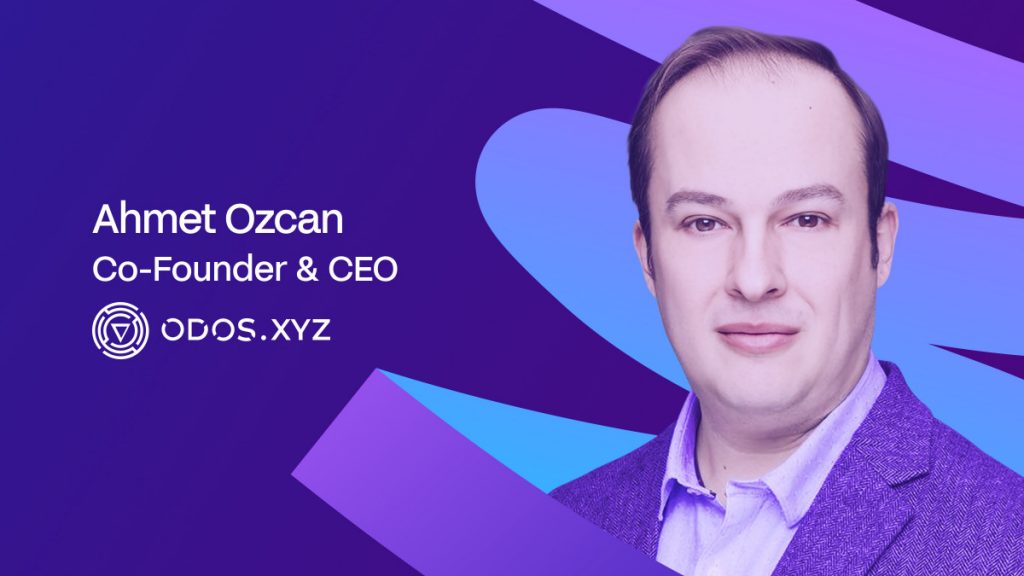How Odos Became DeFi’s Power Engine


In Brief
Odos is revolutionizing DeFi by optimizing trade execution with smart routing, deep liquidity access, and agent-based systems, aiming for seamless, cross-chain, intent-driven transactions.

In a DeFi world increasingly defined by complexity and fragmentation, Odos has carved out a unique role as a powerful execution layer designed to make decentralized trading smarter, faster, and more seamless. Odos is tackling one of the biggest challenges in the DeFi space—delivering the best possible trade outcomes in a highly fragmented and complex environment—by focusing on two key areas: routing optimization and deep, cross-chain liquidity access.
Leading that effort is Ahmet Ozcan, Co-founder and CEO of Odos. In this interview, he shares how the platform came to life, what sets its technology apart, and why the future of DeFi may depend on invisible infrastructure, agent-based systems, and a smarter approach to on-chain execution.
Can you share your journey to Web3?
I actually came to crypto and Web3 a bit late. I was working at IBM for a long time, most recently managing an AI team. So I was already deep into AI when it started to get hot again. Around 2020, I personally got into crypto.
After I quit IBM and started my company, I wanted to work at the intersection of AI and crypto. The other founders also had similar backgrounds, so it was a great fit. But the real turning point came when I met the founders of The Graph Protocol. We started working with them and doing some projects.
Then 2021 came—DeFi summer happened—and that really caught my attention. I was frustrated with the experience, especially on decentralized exchanges. The fragmentation was annoying. Like many founders, I was driven by frustration and a desire to solve a real problem.
With my background in physics, optimization has always been important to me. So, I started focusing on decentralized finance and routing optimization to address the fragmentation issue. My journey into Web3 was a bit later than others, but I think my industry background brings a different perspective.
Could you walk us through how the Odos routing algorithm works? What makes it unique?
Imagine DeFi as a map, where tokens are cities and swaps are roads connecting them. To get from your input token to the one you actually want, you often have to pass through a few cities or tokens.
Odos looks at all possible routes across all the DEXs and pools we support and identifies the most efficient path from start to finish. We start by pulling in a huge number of swap options; then, we begin filtering out the ones that don’t make sense—maybe they require extra tokens or have high gas fees. Through this iterative elimination, we narrow down the options until we find the smartest, most optimal route for your tokens.
What makes Odos different is that we don’t just stitch together individual paths one by one. We run a full optimization over the entire graph of possible swaps and token combinations. That allows us to consistently find better combinations and deliver better prices to users.
Right now, we’re also building a machine learning layer on top of everything to learn from past trades, make smarter decisions faster, and adapt to changing market conditions in real-time. So, the system gets better and better over time.
If you could instantly boost one part of the DeFi ecosystem 10x to benefit Odos, what would it be?
I would 10x the adoption of agentic systems—agent-based DeFi and intent-driven interfaces. As we move away from the click-based DeFi interfaces we use today, users will increasingly rely on autonomous agents to act on their behalf.
Instead of manually executing every swap, users will just express intents like “get me the best price” or “rebalance my portfolio.” This will improve user experience and reduce security risks. Agents can operate 24/7 and do much more than a person trying to navigate everything manually.
So a flourishing agent ecosystem would really drive demand for exactly the kind of infrastructure we’re building at Odos.
How does Odos assess and respond to the challenges of liquidity fragmentation across chains and DEXs, especially with the rise of Layer 2s, appchains, and non-EVM environments?
Liquidity fragmentation has always been an issue, but it’s getting worse with the rise of Layer 2s and appchains. Right now, we’re solving fragmentation within individual chains—aggregating as many DEXs and pools as possible to give users the best execution. But we’re also designing for the long term.
We envision a future where users—and especially agent-based systems—don’t care what chain they’re on. They just want the best outcome. So we’re actively preparing for a world where Odos can serve as an execution engine across environments, handling cross-chain intents, messaging protocols, and even permissioned liquidity when needed.
We don’t believe in constantly moving liquidity to new chains—that’s inefficient. For example, look at what the OP Superchain is doing to solve interoperability within its ecosystem. That’s a great starting point.
As for deciding which chains to support, we carefully monitor where liquidity and users are migrating. Not every chain is worth integrating right away. We consider user demand, sustainability, total value locked, and how active the ecosystem is. We want to meet users where they are without spreading ourselves too thin.
In what ways does Odos contribute to the overall efficiency and price discovery in decentralized markets? Do you think DEX aggregators are under-recognized for their impact?
Yes, absolutely—they are under-recognized. DEX aggregators like Odos play a critical role in making DeFi markets more efficient. By routing orders across fragmented liquidity, we reduce spreads, unify pricing, and make arbitrage harder to exploit.
We help ensure that liquidity is used where it’s needed most, which improves the user experience—even for those not directly using Odos. We act as invisible infrastructure, coordinating flow behind the scenes. Many people don’t realize it’s not just a collection of DEXs—it’s the underlying infrastructure that really powers DeFi.
How do you determine which protocols and chains to integrate with? What standards must they meet?
We get this question a lot from new protocols and chains. We look at a mix of liquidity depth, user demand, technical maturity, and security. Our north star is always user execution quality—does this integration meaningfully improve it?
We also look at composability and how stable the protocol is, how easy it is to monitor and maintain, and whether there’s real economic activity—not just farming and then abandonment. We try to balance activity and security, which are the two most important factors.
Odos has been integrated with several major protocols. What defines a valuable or strategic partnership for you?
We define strategic partnerships by three key things: meaningful liquidity, infrastructure innovation, and shared distribution. A good partner either brings assets and pools our users need, offers infrastructure like bridges or intent layers that enhance our routing, or helps extend our reach to more users.
We also value philosophical alignment—partners who believe in abstraction, composability, and reducing user friction. Strategic value goes both ways: the protocols we integrate into and the platforms that integrate us—like wallets, dashboards, meta-aggregators, and agents. These partners use Odos as a backend engine to deliver the best trades, which extends our execution flywheel and strengthens the ecosystem.
As DeFi begins intersecting with AI-driven agents, modular execution, and RWAs, how does Odos plan to stay relevant and responsive?
We’re already positioning Odos as the execution backbone for this next phase of DeFi. On the agent side, Odos is already being used behind the scenes by early intent-based systems. We’re designing interfaces for goal-oriented execution so agents can request actions like rebalancing or liquidating without micromanaging every step.
On the modular execution front, we’re making Odos composable so it can plug into various environments—whether it’s rollups, shared sequencing, or programmable automation layers.
As for RWAs (real-world assets), the opportunity is huge. These assets still need efficient, secure on-chain execution—especially in the early stages. Whether it’s tokenized treasuries or real estate, Odos can ensure efficient transaction routing.
Could Odos evolve into something beyond a DEX aggregator—maybe a broader execution layer for on-chain finance?
I actually don’t like calling Odos an aggregator, as it suggests we just collect liquidity. But we think of it more as an agentic navigation layer for on-chain finance.
As DeFi shifts toward intent-based and agentic systems, we need infrastructure that can translate high-level goals into optimized on-chain execution. High-level agents like LLMs are great for planning, but they can’t manage DeFi’s real-time dynamics. That’s where Odos comes in—we’re building for exactly that future.
What are the most underappreciated technological or structural trends in DeFi today that Odos is preparing for?
One is RWAs and the need for permissioned execution. Many partners require KYC/AML-compliant access to permissioned liquidity pools. We’re designing Odos to support these requirements while still delivering strong execution so institutional users can stay on-chain rather than moving to centralized exchanges or walled gardens.
The second underappreciated trend is agentic systems. Many people still think of them as simple bots. However, as someone with an AI background, I see how multi-agent systems are already changing things outside Web3. Once AI experts start building in crypto, how people interact with DeFi will be a game-changer.
What would a truly optimal decentralized trading experience look like? What are the remaining barriers?
It should feel like magic. Users express what they want—the system handles the rest. Our goal is to become invisible.
It should be chain-agnostic, trust-minimized, and efficient. But risk management and user experience are still the biggest hurdles. People still trust centralized exchanges more, especially in some countries. They struggle with wallets, smart contract risks, MEV.
But agents don’t care about trust—they operate programmatically. Agentic execution can help remove those psychological barriers and bring us closer to a truly decentralized experience.
Can you please share the roadmap for Odos?
We published our roadmap at the beginning of the year. This year, we’re focused on cross-chain capabilities—not just bridging but seamless experiences for DeFi users. We’re also moving beyond EVM chains, with Solana at the top of the list.
Longer-term—and even within this year—we’re preparing for RWAs, working with institutional users, and understanding what agentic systems really need. We’re having fascinating conversations with these partners, and we’re excited to launch new solutions next year based on what we’re learning.
Disclaimer
In line with the Trust Project guidelines, please note that the information provided on this page is not intended to be and should not be interpreted as legal, tax, investment, financial, or any other form of advice. It is important to only invest what you can afford to lose and to seek independent financial advice if you have any doubts. For further information, we suggest referring to the terms and conditions as well as the help and support pages provided by the issuer or advertiser. MetaversePost is committed to accurate, unbiased reporting, but market conditions are subject to change without notice.
About The Author
Victoria is a writer on a variety of technology topics including Web3.0, AI and cryptocurrencies. Her extensive experience allows her to write insightful articles for the wider audience.
More articles

Victoria is a writer on a variety of technology topics including Web3.0, AI and cryptocurrencies. Her extensive experience allows her to write insightful articles for the wider audience.

















































